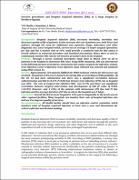| dc.contributor.author | Okello, Tom Richard | |
| dc.contributor.author | Kansiime, Jackson | |
| dc.contributor.author | Odora, J. | |
| dc.date.accessioned | 2021-05-23T12:38:44Z | |
| dc.date.available | 2021-05-23T12:38:44Z | |
| dc.date.issued | 2014 | |
| dc.identifier.citation | Okello, T. R., Kansiime, J., & Odora, J. (2014). Invasive procedures and hospital acquired infection (HAI) in a large hospital in northern Uganda. East and Central African Journal of Surgery, 19(3), 77-84. | en_US |
| dc.identifier.issn | 2073----9990 East Cent. Afr. J. s9990 East Cent. Afr. J. s9990 East Cent. Afr. J. s9990 | |
| dc.identifier.uri | https://hdl.handle.net/123456789/267 | |
| dc.description.abstract | Background: Hospital Acquired Infection (HAI) increases morbidity, mortality and decreases quality of life of patients. It also increases the cost of patient care, both direct and indirect, through the need for additional and expensive drugs, laboratory and other diagnostic test. Lacor hospital which, carries-out on average 16 major surgical operations per day and has C/section rate of 14% could provide a conducive hub for HAI unless it strictly adheres to universal procedure and Standard precautions. Hence there is need to continuously monitor HAI rate for all invasive procedure done in the hospital. Methods: Through a across sectional descriptive study done in March 2014 on all in patients in the hospital to determine HAI rates. Using WHO standards, HAI was determined in the following invasive procedures; intravenous line sepsis, surgical site infection, urinary tract infection, Lower respiratory tract infection. Data collected was entered and analyzed using SPSS version 15. Results: Approximately 129 patients fulfilled the WHO inclusion criteria for HAI survey out of which, 18 patients (14%) were found to be having HAI as according to WHO guideline. Of the 18, 10 had been catheterized and there was a significant correlation between catheterization and HAI (r=0.319, P=0.00) but Urinary tract infection (UTI) rate in hospital was 38%. The rate of surgical site infection (SSI) was 21.9% and there was significant correlation between surgical intervention and development of HAI (P value of 0.003, r=0.259). However, only 3 (3%) of the patients with intravenous (IV) line had IV line infection and the average duration of IV line in-situ in the hospital was 2.4days. Conclusion: Overall the HAI in Lacor hospital is 14% and is comparable to the levels seen in other regional facilities. Many hospitals can monitor their rate of hospital infection rate and use it to improve quality of services. Recommendation: All health facility should have an infection control committee which monitors rates of hospital acquired infection at least once a year and disseminate for critical reflection and decision making. | en_US |
| dc.language.iso | en | en_US |
| dc.publisher | East and Central African Journal of Surgery | en_US |
| dc.subject | Invasive procedures | en_US |
| dc.subject | Hospital Acquired Infection | en_US |
| dc.subject | Northern Uganda | en_US |
| dc.title | Invasive procedures and Hospital Acquired Infection (HAI) in A large hospital in Northern Uganda. | en_US |
| dc.type | Article | en_US |

